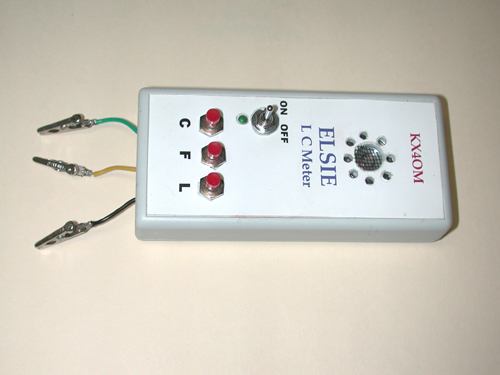
ELSIE LC Meter
Some years ago, I had long needed a device to measure inductance and capacitance in the nanohenry-microhenry range, and the picofarad and above range. I read about the ELSIE Morse readout LC meter on a web site site back in 2007, I guess, as it used to be sold as a kit by a ham organization. I had been using the inexpensive Rainbow Kit version of the design that is in several editions of the ARRL Handbook, and it is surprising accurate, even down in the picofarad range, but a bit fiddly to use. That one is housed in a mint tin.
I quickly decided
to do the ELSIE PC board in EAGLE
CAD, and it is a simple board to do. I used the toner transfer method of creating
the PC board. I have several 1% tolerance capacitors from the low picofarad
to .1 microfarad ranges that I use to check the calibration before I use it
for measuring capacitance.
With it, I've measured and labeled my stash of
variable caps. I use it to parallel and then measure caps for close to ideal
values for LC and crystal filters. The limitation is that it can't "display"
values like 8.5 pF; it rounds off to the nearest whole digit for those low values.
It will display to the nearest pF for 2-digit and 3-digit values, for selecting
among a group of 100 PF-marked caps, for example. It will let me know if a .01
cap is actually .0095, or .0082. I use it to measure the parallel capacitance of
crystals for use in filters, and getting a reading of 4, 5 or 6 pF is close enough
for me to plug into the equation.
It is able to measure inductors lower than 1 uH,
which is very useful for getting good accuracy when winding toroid coils. I've had a
homebrew-from-plan (VK3BHR) PIC 16F628-based, LCD readout replacement with greater
precision, if not necessarily better accuracy about 75 percent complete since about 2011.
The homebrew board is complete and stuffed, the PIC is programmed, and I basically just
need to put it in an appropriate case. Meanwhile, I just keep reaching for the ELSIE for
projects in the queue, and for taking to HamFests to measure chokes,
variable capacitors and such.
In order to program the Atmel AVR chip (similar to a PIC microcontroller), I had to build a flash programmer for the AT90S2313 IC. I decided on the just about the simplest one I could find, out of many, the TwinAVR, which can use the simple, command-line SP12 programmer by Steven Bolt. The programmer connects to the parallel port of the PC, and the SP12 commands dump a hex file into the microcontroller. Below is a photo of the TwinAVR board that I made using toner transfer. Click to enlarge.
TwinAVR Programmer
Following are build photos of the project.
The wired PC board
The wired board, foil-side
Fitting to the case
Finished ELSIE